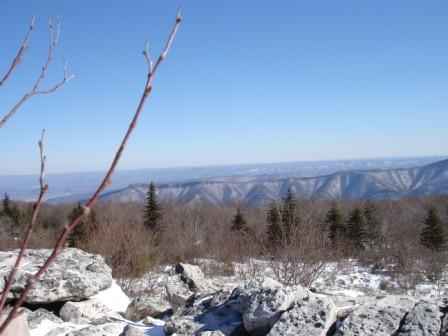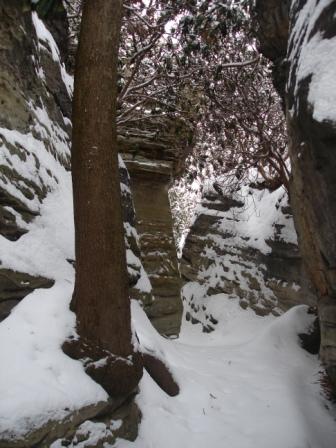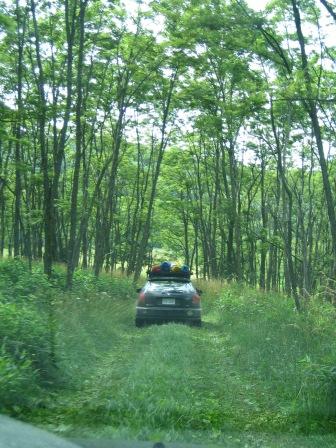Cheat Canyon, as mentioned in early posts, has been eluding me. This stretch of river is known for it's scenery and remoteness, but that's not the real reason that I've been so anxious. In November of 2005, an advanced whitewater canoeist from DC named RC Forney, who I did not know, drowned in one of Cheat Canyon's class IV rapids after missing his line, flipping out of his canoe, and becoming entrapped on a submerged dead tree. The original post on the message board of the Monocacy Canoe Club came on the evening of the tragic incident, and is reproduced here.
It is my sad duty to report that RC Forney died yesterday at Pete Morgan rapid on the Cheat River. RC was paddling an open boat. The level was 3 feet.
RC was having a very good day. He had just declined an opportunity to sneak Upper Coliseum and had run a perfect line through the meat of that difficult rapid. As he approached the entrance to Pete Morgan, he was off-line to the right. He hit the hole above the large rock on the right side of the entrance and then was swept sideways into that rock. He flipped and came out of the right side of his boat into the violent rectangle of water created by the four boulders that are just to the right of the standard line. His boat came down the rapid quickly, but we never saw RC after he came out of his boat at the top right of the rapid. We chased and flipped his boat upright in the hope that he was under it, but he was not. We went up the rocks on the left side and searched for him from every spot we could reach.
When we started to look for him, we realized for the first time that there was a large tree parallel to the standard line and about 2 feet to the right. The tree is wedged into the severely undercut left side of the large rock on the right side of the entrance and into the other large rock at the bottom right of the rapid. We also searched by boat from the bottom of the rapid and from the top of the cliff on the right side of the river. Two local paddlers came down the river and joined the search, to no avail.
The West Virginia state police sent an infrared-equipped helicopter to the scene last night, and the state police and local rescue squad are conducting a thorough search today.
The other participants in this tragic trip were Lee Thonus, Cahil Converse, Terry Irani, and Gisela Zarcusky. Lee is assisting with the body recovery effort today. RC left behind his wife, Dana, and 2 children, aged 4 years and 10 months. I will miss RC a lot. He was a wonderful person.
When a paddler dies, the tight-knit community rallies. The post above generated a record number of responses. The reaction is almost always the same. Condolences are followed by analysis. The event is reiterated by all present parties and rescue personnel. Potential to learn from the accident is emphasized, and any contributing factors that are reasonable enough to address are removed. In this case, the submerged tree was removed from the boulder below which it was stuck, and I was told that within a few days it was on the shore near the rapid and a small flag was tied to it, honoring its significance.
I've run two rivers before that had claimed lives. This was different, however, because the others (Lower Yough and New) had never taken the life of a private boater with an advanced set of skills. On the Lower Yough, all deaths have been rafters. On the New, those who have died who were not rafters were in above their head and were either unable to make the necessary maneuvers or perform an eskimo roll. From what I've read and been told, RC was quite capable for the Cheat Canyon.
Aside from the mental block that was RC's tragic accident on the Cheat, the canyon is a very long run (9.5 miles with a significant portion of flatwater) and it was quite cold last Friday. However, the day before, I'd met a group of two Baltimorons (that title keeps getting better) to run the Lower Big Sandy for my second time, and with the small group and a water level equal to last week's run, we were all comfortable just running the rapids without getting out of the boats and scouting in most cases. That meant that the run was much quicker and I came out of it much more confident. In fact, it was my idea to run Cheat Canyon the next day. I got back to the apartment and told Rob that -- if he was up for it -- he should come along. Rob had a mental block of his own in that he'd walked off the Cheat a year ago after making the decision that he was not sufficiently skilled to paddle past the first rapid. Since that time, he's gotten considerably better.
We ended up with a crew of five. The river is indeed beautiful, and there is indeed a great deal of whitewater. There were two swims, though the first was into a pool of flatwater. The second, however, was concerning. The last two rapids are called Coliseum and Pete Morgan. I don't know the origin of the name of this latter drop, but I had studied it intimately because it is where RC Forney died. The rapids have names due to the fact that there is a well accepted best way to run it. If all rapids in the canyon had this property, then there would be far more named rapids; in short, most rapids are "point and shoot." Coliseum has two hydraulics in it that should not be entered by kayaks (rafts would be okay, just as a sports car shouldn't be in many places a Jeep would be required). The first is on the right, and the second on the left. So, what most boaters should do is to start way over on the left to avoid the top hole, paddle into an eddy on the side (where there is little current behind a boulder), and then cross the current from there (called "ferrying") to get to the other side of the river and avoid the bottom hole. The paddler who swam here was able to catch the eddy (the hard part over), but failed to ferry hard enough to get to the opposite side of the river. This meant that he was washed into the bottom hole, which sucked him in for a bit. He attempted a few rolls, but when one is upside down in a big hydraulic, it is often very disorienting and difficult to properly set up to roll. After his failed attempts, he decided to pull his skirt and swim out of it. As in most cases, this meant that the boat and paddler both began drifting downstream because the physical properties (bouyancy and shape) of the boat/paddler system was disrupted, and the physical properties of the two apart from each other was significantly different enough and they both washed out. The paddler was not shaken and started to swim for shore.
So far, so good. But, I was aware that Coliseum had a lower section and that Pete Morgan was not far downstream. Swimming through the lower section was not a problem, and I paddled straight for him so that he could hold onto my boat. He did this with a few of us, progressively getting closer to shore each time. At one point, somebody found his paddle and threw it ashore. By the time he was on land, we'd come through Lower Coliseum and he gave us the "A-Okay" sign. The boat was now the issue, and two of the paddlers were in pursuit. Rescues such as this are common enough that they become more routine, and while the safety of the swimmer takes priority, in a remote canyon on a cold day such as this, the swimmer's safety is also dependent on recovering the boat and paddle.
The other paddler who I'd been staying with up until this point said to me, "Dude, that's Pete Morgan!!" and my heart skipped. I was confident in my ability to navigate rapids unscouted, but this was the one from which my anxiety had stemmed that day. I quickly paddled into an eddy. Looking up to see the now former swimmer starting to walk downstream along a sheer cliff by bouldering, I clearly found myself in a relatively safe position to appreciate how the day must have been when RC Forney died. The two paddlers who had chased the empty boat were below the rapid and out of sight and the only other paddler in his boat was now with me in the eddy. We agreed to get out and scouted Pete Morgan despite my fixation with this rapid. With one look, I felt confident with it and took a moment to silently honor its victim. We leapt into our boats and ran Pete Morgan without incident. The two others were calmly waiting in the eddy below the rapid with the boat we'd all been chasing. This was the last rapid, and by the time we emptied the water-logged boat, its paddler had reached us. The rest was what we call "Boogie Water," and so I knew that Cheat Canyon was another feather in my cap. As mountaineers say, we knocked the bastard off.
In all, the river was a fantastic and fun run. I am happy to have it under my belt and look forward to more trips down it. Next time I'll bring my camera. Because of my concerns about this river, I decided not to bring it along. If I'm ever feeling anxious about an activity, I tend to keep the activity the focus. Something about being on my "A-game."
Git 'r Dun.
The Motivation for this Journal
My name is Matt and I play in West Virginia. Actually, I'm addicted to the state.
Living inside or within a few hours of a WV state border for all of my life, I've had plenty of "West Virginia Moments," a characterization that could range from WV stereotype reinforcements of the cultural (could be bad) to the natural persuasion. Fortunately, the number of the latter is far greater than the number of former.
I wish to document with this blog these "West Virginia Moments." If you're reading this, then you are a friend or family member, or have stumbled upon this blog, and I thank you for reading and hope you'll get a laugh, discover a new natural place in WV, or gasp at the thought of it. However, the real reason for this blog is personal. I will consider this blog an archive of these moments for a man with a poor memory.
Enjoy!
Living inside or within a few hours of a WV state border for all of my life, I've had plenty of "West Virginia Moments," a characterization that could range from WV stereotype reinforcements of the cultural (could be bad) to the natural persuasion. Fortunately, the number of the latter is far greater than the number of former.
I wish to document with this blog these "West Virginia Moments." If you're reading this, then you are a friend or family member, or have stumbled upon this blog, and I thank you for reading and hope you'll get a laugh, discover a new natural place in WV, or gasp at the thought of it. However, the real reason for this blog is personal. I will consider this blog an archive of these moments for a man with a poor memory.
Enjoy!




